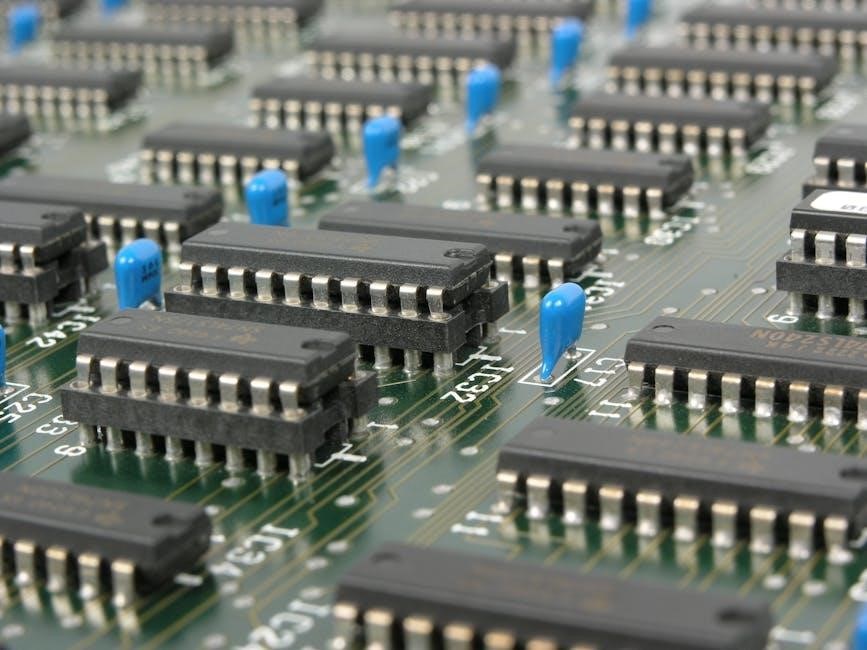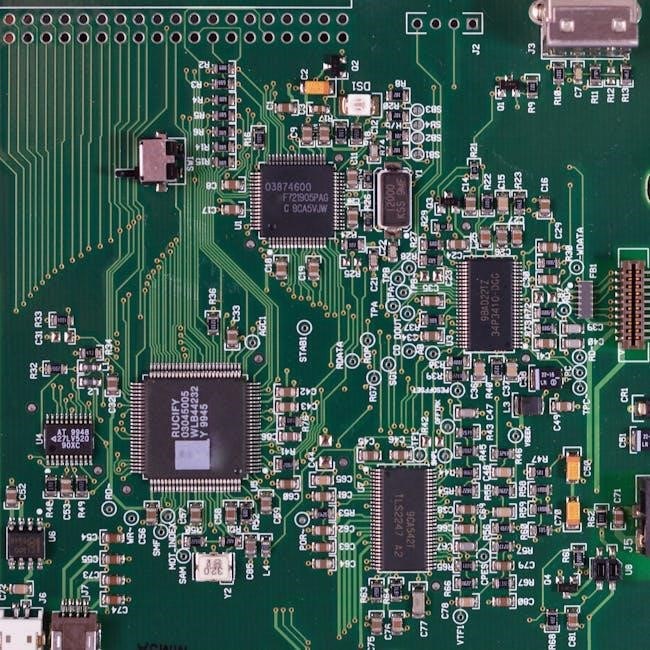The integumentary system, comprising skin, hair, nails, and associated glands, forms the body’s protective barrier. It regulates temperature, aids in sensation, and synthesizes vital nutrients like vitamin D.
1.1 Definition and Overview
The integumentary system, the body’s largest organ, comprises skin, hair, nails, and associated glands. It acts as a protective barrier against pathogens, regulates body temperature, and aids in water retention. The skin, its primary component, consists of the epidermis, dermis, and hypodermis. Accessory structures like hair follicles and sweat glands enhance its functionality. This system is crucial for maintaining homeostasis and facilitating sensory perception, making it vital for overall health and survival.
1.2 Importance of the Integumentary System
The integumentary system is vital for protecting the body from external damage, pathogens, and harmful UV radiation. It regulates body temperature, aids in water retention, and enables sensory perception through receptors. Additionally, it synthesizes vitamin D, essential for bone health. The system also acts as a barrier against environmental stressors, maintaining internal homeostasis. Its functions are indispensable for overall health, making it a cornerstone of bodily defense and physiological balance.
Functions of the Integumentary System
- Protects against injury and infection
- Regulates body temperature
- Enables sensory perception
- Regulates water loss
- Aids in vitamin D synthesis
2.1 Protection Against Injury and Infection
The integumentary system acts as the body’s first line of defense, protecting against external injuries and infections. The skin’s outer layer, the epidermis, provides a physical barrier, while its natural moisture and pH balance inhibit microbial growth. Keratin, a protein produced by keratinocytes, strengthens the skin, making it resistant to abrasions. Additionally, the skin hosts immune cells that detect and combat pathogens, further safeguarding the body from harm. This dual protection ensures the body remains shielded from environmental threats.

2.2 Regulation of Body Temperature
The integumentary system plays a vital role in maintaining body temperature through sweat production and blood vessel regulation. Sweat evaporation cools the body, while blood vessels in the dermis dilate or constrict to release or conserve heat. This thermoregulatory function ensures the body remains within a stable range, essential for proper physiological processes; The skin’s adaptability allows it to respond effectively to environmental changes, making it a crucial component in homeostasis.
2.3 Sensory Perception
The integumentary system enables sensory perception through specialized receptors in the skin. These receptors detect stimuli like touch, pressure, pain, heat, and cold. Nerve fibers transmit these signals to the brain, allowing us to perceive and respond to environmental changes. Specific receptors, such as Pacinian corpuscles (detecting vibration and pressure) and Meissner’s corpuscles (sensing light touch), highlight the skin’s role as a sensory interface, essential for interaction with the external world and maintaining bodily awareness.
2.4 Regulation of Water Loss
The integumentary system regulates water loss through the skin, acting as a barrier to prevent excessive fluid loss. The stratum corneum, the outermost layer of the epidermis, provides a waterproof barrier. Sweat glands produce sweat, which evaporates to cool the body, thereby controlling water loss. This mechanism is crucial for maintaining fluid balance and preventing dehydration. Proper regulation ensures the body retains necessary moisture while adapting to environmental conditions, such as temperature and humidity, to sustain homeostasis.
2.5 Chemical Synthesis
The integumentary system plays a role in chemical synthesis, primarily through the production of vitamin D. When sunlight interacts with the skin, it triggers the synthesis of cholecalciferol, a precursor to active vitamin D, essential for calcium absorption and bone health. Additionally, the skin metabolizes various nutrients and hormones, contributing to the body’s overall chemical balance and maintaining homeostasis through these intricate processes.

Common Disorders and Conditions
Common disorders include hypohidrosis (reduced sweating), paronychia (nail inflammation), and melanoma (skin cancer). These conditions highlight the integumentary system’s vulnerability to environmental and internal imbalances.
3.1 Hypohidrosis
Hypohidrosis is a condition characterized by reduced sweating, impairing the body’s ability to regulate temperature. It can result from nerve damage, certain medications, or genetic disorders. In severe cases, it may lead to heatstroke. Treatment options include medications to stimulate sweat glands or addressing underlying causes. Proper hydration and cooling measures are essential for managing symptoms and preventing complications. Awareness of this condition is crucial for maintaining overall health and thermoregulation.
3.2 Paronychia
Paronychia is an inflammation of the skin around the nail, often caused by bacterial or fungal infections. It can be acute or chronic, with symptoms like redness, swelling, and pain. Treatment typically involves antibiotics, keeping the area dry, and sometimes draining pus. Proper hygiene and avoiding excessive water exposure help prevent the condition. Addressing Paronychia early is crucial to prevent complications and promote healing.
3.3 Melanoma
Melanoma is the most aggressive form of skin cancer, arising from melanocytes. It often appears as a new or changing mole, with key signs including asymmetry, irregular borders, multiple colors, and a diameter larger than 6mm (ABCDE rule). Early detection is critical for treatment. Risk factors include excessive UV exposure, fair skin, and a family history of the disease. Prompt medical evaluation is essential if suspicious lesions are observed.

Anatomy of the Skin
The skin consists of three layers: the epidermis, dermis, and hypodermis. The epidermis is the outermost layer, containing keratinocytes. The dermis holds blood vessels, nerves, and glands, while the hypodermis stores fat and connects skin to underlying tissues.
4.1 Epidermis
The epidermis is the outermost layer of the skin, composed primarily of keratinocytes. It is a stratified epithelium with several sublayers, including the stratum corneum, where dead cells form a protective barrier. The epidermis protects against pathogens, UV radiation, and water loss while providing a durable external shield. It lacks blood vessels, relying on the dermis for nourishment. This layer continuously regenerates, with cells migrating upward to replace shed skin, ensuring the body’s first line of defense remains intact and functional.
4.2 Dermis
The dermis, located beneath the epidermis, consists of dense connective tissue. It contains blood vessels, nerve endings, hair follicles, and sweat and sebaceous glands. This layer provides the skin with elasticity and strength, enabling it to stretch and return to its original shape. The dermis plays a vital role in regulating body temperature, facilitating sensory perception, and supporting the epidermis with essential nutrients and oxygen. It also aids in the production of oils and sweat, which are crucial for skin health and hydration.
4.3 Hypodermis
The hypodermis, also known as subcutaneous tissue, is the deepest layer of the skin. Composed primarily of fatty tissue, it cushions the body, provides insulation, and absorbs shocks. This layer anchors the dermis to underlying muscles and bones while storing energy in the form of fat. It also houses larger blood vessels, lymphatic vessels, and nerve endings, facilitating the exchange of nutrients and waste. The hypodermis plays a crucial role in maintaining body temperature and supporting overall skin health.

Accessory Structures of the Integumentary System
Accessory structures include hair, nails, and glands. Hair provides protection, nails shield tips of fingers/toes, while sebaceous and sweat glands produce oils and regulate body temperature respectively.
5.1 Hair and Hair Follicles
Hair is a keratin-based structure projecting from follicles in the skin. Each follicle contains an arrector pili muscle and sebaceous gland; The hair shaft, bulb, and root are key components. Hair provides insulation, protects against external factors, and aids in UV protection. Melanocytes produce pigment, giving hair its color. Hair growth occurs in phases: anagen (active), catagen (transitional), and telogen (resting). Understanding these structures is essential for integumentary system worksheets, often focusing on their functions and anatomical details.
5.2 Nails
Nails are hardened keratin structures at the tips of fingers and toes, serving as protective barriers and aiding in tasks like gripping. The nail plate is the visible part, while the nail bed beneath it contains blood vessels and nerves; The root and matrix are crucial for growth. Conditions like paronychia highlight their importance in integumentary system health. Understanding nail anatomy and function is key for worksheet answers, focusing on their role in protection and sensory input.
5.3 Sebaceous and Sweat Glands
Sebaceous glands produce sebum, an oily substance that lubricates and protects the skin and hair. Sweat glands, or sudoriferous glands, produce sweat, aiding in thermoregulation. Eccrine glands are widespread, while apocrine glands are concentrated in areas like the armpits. These glands play a vital role in maintaining skin health and regulating body temperature. Understanding their functions is essential for answering worksheet questions on the integumentary system, as they are crucial for hydration and protection.

Key Terminology and Definitions
Epidermis: The outermost layer of skin, composed primarily of keratinocytes. Dermis: The layer beneath the epidermis, containing blood vessels, nerves, and glands. Hypodermis: The subcutaneous tissue layer, providing insulation and cushioning. Melanin: The pigment responsible for skin color. Keratin: A protein that strengthens skin, hair, and nails. Hypohidrosis: Reduced sweating. Sebum: The oily secretion from sebaceous glands. These terms are essential for understanding integumentary system functions and disorders.

Importance of Melanin in Skin Health
Melanin protects the skin from harmful UV radiation, reducing DNA damage and cancer risk. It also determines skin color and aids in vitamin D synthesis. Melanin’s antioxidant properties help prevent skin aging, making it crucial for overall skin health.

Common Questions and Answers from Worksheets
What are the layers of the skin? The skin has three main layers: the epidermis, dermis, and hypodermis.
What is the function of melanin? Melanin protects the skin from UV radiation and gives it color.
What are the types of skin glands? Sweat glands and sebaceous glands.
What is hypohidrosis? Reduced sweat production.
What is the hypodermis? A subcutaneous layer of fat and connective tissue.

Tips for Answering Integumentary System Worksheet Questions
Focus on understanding key functions like protection, temperature regulation, and sensation. Review definitions of terms such as hypodermis, melanin, and sebaceous glands. For multiple-choice questions, eliminate incorrect answers first. Practice labeling diagrams of skin layers and glands. Pay attention to common disorders like hypohidrosis and melanoma. Use process of elimination for unclear questions. Lastly, review mistakes to avoid repeating them in future assessments.
The integumentary system is vital for protection, temperature regulation, sensation, and synthesizing nutrients like vitamin D. Understanding its components—skin, hair, nails, and glands—enhances appreciation for its role in overall health; Regular study and practice with worksheets ensure mastery of key concepts and terminology, aiding in successful completion of assessments and deepening knowledge of this essential bodily system.

Additional Resources for Further Study
For deeper understanding, explore Anatomy and Physiology lecture notes, skin histology labs, and worksheet answer keys. Resources include PDF guides on the epidermis, dermis, and hypodermis, as well as interactive exercises covering sensory perception and gland functions. Websites offer fill-in-the-blank exercises, case studies, and diagrams for visual learners. These tools provide comprehensive insights into the integumentary system, aiding in both academic and self-directed learning opportunities.